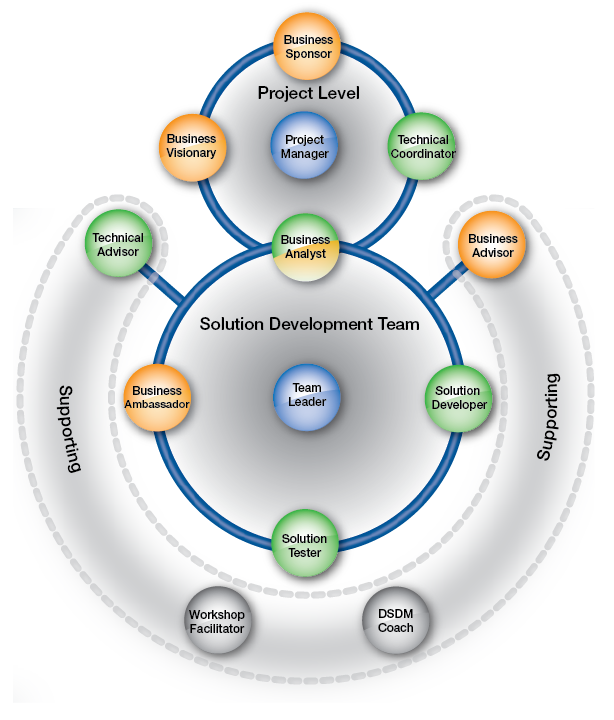Understanding The Roles in The Dynamic Systems Development Method (DSDM)
In the orchestra of project management methodologies, where each note plays a crucial part in the symphony of success, the Dynamic Systems Development Method (DSDM) emerges as a conductor of innovation and adaptability. Picture a world where change is not a disruption, but a welcomed rhythm, and excellence is not a destination, but an ongoing journey.
At the heart of DSDM’s transformative melody lies a cast of distinctive roles – each a protagonist in its own right, weaving a narrative of collaboration, precision, and collective triumph. Embark with us on an exploration of the captivating tapestry that is DSDM’s role landscape, where conventional boundaries blur, and project management reaches new crescendos of achievement.
Before your deep dive into this article, we recommend you take a look at our complete guide to DSDM if you haven’t already.
Role Categories
Within DSDM, roles are organised into three distinct levels or categories. These encompass the Project Level, the Solution Development Team, and roles associated with Support functions. The core Project Team is situated within both the Project Level and the Solution Development Team.
Project Level Roles
Roles at the Project Level focus on overseeing and/or supervising specific project aspects within their respective expertise or domain. Within this tier, individuals hold responsibilities for engaging with stakeholders and upholding project governance. Their pivotal role involves shaping the project’s overarching vision and diligently ensuring its alignment throughout the project’s progression.
Solution Development Team Roles
The Solution Development Team (SDT) holds the accountability for materialising the envisioned project outcomes. Through seamless collaboration, they collectively construct the intended project deliverables. Whenever possible, it’s advisable to maintain continuity within these roles, avoiding unnecessary changes or replacements. The ultimate aim is to foster a steadfast SDT that assumes ownership of its tasks and designated domains.
Supporting Roles
Supporting Roles offer project guidance whenever required. They might extend their support to several projects or hold alternative positions within the organisation. Within a project context, their contributions are geared towards offering counsel and assistance to the Solution Development Team, leveraging their specialised expertise.
The DSDM Team Model

In Figure 7a, the colour scheme is outlined as follows:
- Orange: Reflects business interests, encompassing roles that articulate the business perspective. Typically, these roles are assumed by business personnel such as the Business Ambassador, who offers day-to-day business direction, and the Business Visionary, who provides overarching direction and a future-oriented viewpoint.
- Green: Represents solution/technical interests, housing roles that advocate for the solution’s technical aspects. These roles contribute to the technical evolution of the solution. For instance, Solution Developers actively create the solution, while the Technical Coordinator furnishes technical leadership and guidance.
- Blue: Signifies management interests, incorporating roles that convey the management and leadership viewpoint. These roles facilitate the management and leadership facets of the project. Examples include the Project Manager and Team Leader, who adhere to the DSDM process while overseeing a DSDM project using Agile leadership competencies.
- Grey: Symbolizes process interests, involving roles that underscore the process perspective. These roles facilitate the procedural dimensions of the project. For instance, the Workshop Facilitator manages the workshop process, while the DSDM Coach embeds the DSDM framework into the project’s workflow.
- Mix of Two Colors: This category corresponds to roles that bridge two distinct areas of interest. For example, the Business Analyst operates with both a business and a solution/technical focus, demonstrating the convergence of these two realms.
DSDM Roles
Project Level Roles
Business Sponsor

The role of the Business Sponsor holds a pivotal position at the senior level within the project hierarchy. Functioning as a project advocate, the Business Sponsor assumes accountability for both the project’s business case and its financial allocation. Given the imperative to make critical business and financial determinations, this role necessitates elevated organisational authority. In instances where a project falls within a DSDM programme, the Program Manager might fulfil this role.
For more extensive and intricate projects, the Business Sponsor’s responsibilities could be undertaken by a committee. To streamline issue escalation and mitigate conflicts, the organisation should ideally designate a solitary individual or a unified committee/board for this role. This approach offers a clearer avenue for issue resolution compared to the complexity that can arise from multiple independent individuals attempting to fulfil the role.
Key Responsibilities encompass:
- Safeguarding the project’s Business Case.
- Overseeing the project’s financial aspects.
- Facilitating robust decision-making processes.
- Addressing escalated conflicts.
- Empowering other business roles to excel in their contributions.
- Maintaining a well-informed and engaged stance regarding the project’s status and ongoing activities.
Business Visionary
The role of the Business Visionary revolves around comprehending the business requirements and communicating the overarching business vision to the project team. This role is crucial in order to establish and maintain a consistent and unambiguous vision for the project throughout its lifecycle. When a project operates within a programme, the Business Visionary’s responsibilities may be carried out by the Business Change Owner role within DSDM programme management.
Key Responsibilities include:
- Articulating the business vision and effectively conveying it to the team and other stakeholders.
- Addressing conflicts that pertain to the business vision.
- Ensuring that the project’s advancement aligns with the established business vision.
- Offering insights into the interpretation of project change requests.
- Contributing to sessions focused on design and review, particularly those pertaining to the business vision.
- Allocating business resources for the project.
- Providing a form of servant-leadership to the business roles within the project.
Business Analyst

Operating within the Solution Development Team while providing support to Project Level roles, the Business Analyst assumes an intermediary role that bridges these two spheres. This position serves as a conduit between the Project Level and the SDT, offering guidance to the SDT in making well-informed decisions during solution development.
Key Responsibilities involve:
- Collaborating with the Business Visionary to propel the evolution of the business vision.
- Recognizing potential risks and evaluating their potential effects on solution implementation.
- Aiding the Project Level in the creation of the business case.
- Facilitating communication when required to ensure effective information flow.
- Ensuring that requirements are comprehensively defined and attainable.
Business Ambassador
The role of the Business Ambassador entails advocating for the business requirements within the Solution Development Team. Throughout the process of Evolutionary Development, they furnish the team with daily requirements and hold the principal authority for business-related decisions.
Primary Responsibilities include:
- Participation in sessions related to requirements, design, and review.
- Offering the business perspective to guide decisions in solution team development.
- Taking charge of documenting the solution as well as its accompanying support documentation.
- Ensuring that users are adequately trained on the implemented solution.
Business Advisor
The role of the Business Advisor revolves around ensuring that the testing of the solution aligns with the business requirements. This role can encompass a Subject Matter Expert, a potential future user of the solution, or someone who offers regulatory and legal insights. The Business Advisor provides guidance on the solution from a focused and intricate business standpoint.
Key Responsibilities include:
- Offering specialised insights that contribute to the refinement of the solution.
Solution Development Team
Technical Coordinator

The role of the Technical Coordinator encompasses serving as the project’s technical authority, responsible for orchestrating and structuring technical endeavours. This individual provides the technical vision for the project and endeavours to ensure its alignment with the overarching business vision. Within a DSDM program, the role of the Technical Coordinator might be occupied by the Program Technical Architect.
Key Responsibilities involve:
- Supervising the technical architecture of the project.
- Coordinating the various technical activities.
- Offering guidance on the feasibility of technical solutions.
- Assessing potential technical alternatives to meet the business objectives.
- Upholding adherence to technical best practices.
- Managing the progression of the developed solution into a released state.
- Empowering the technical project roles through a form of servant-leadership.
- Addressing conflicts stemming from technical decisions.
Solution Developer
The role of the Solution Developer involves transforming business requirements into a Solution Increment tailored to fulfil the specific increment’s demands. This encompasses various roles essential for the solution’s completion or an incremental part of it. Ideally, this role should be committed full-time to the project to minimise risks and inefficiencies.
Key Responsibilities include:
- Collaborating in the joint development of an incremental segment of the solution during each iteration.
- Abiding by technical limitations and the organisation’s established development standards.
- Engaging in quality assurance measures.
Solution Tester
The role of the Solution Tester revolves around ensuring the functionality of the solution, and conducting tests in accordance with established standards.
Key Responsibilities encompass:
- Defining the requisite testing requirements and outlining scenarios for test cases.
- Conducting tests for both the solution increment and the entirety of the solution.
- Monitoring and reporting on testing activities and any quality-related concerns.
Technical Advisor
The role of the Technical Advisor entails offering technical assistance for the solution. This could encompass responsibilities such as managing operational adjustments, aiding in the release process, or ensuring the ongoing maintenance of the solution.
Key Responsibilities include:
- Assessing the technical requirements and offering specialised insights.
- Conducting operational acceptance testing.
- Delivering training sessions on technical operations to support staff.
Supporting Team
Project Manager

The Project Manager assumes the role of an Agile-oriented leader within the team. In the context of DSDM, this role leans more towards being a servant or facilitative leader rather than adopting an authoritative leadership approach. The Project Manager’s role involves coordinating and empowering the entire team while orchestrating the harmonious integration of various components.
Key Responsibilities involve:
- Facilitating prompt and efficient communication channels.
- Undertaking high-level planning activities.
- Engaging with stakeholders to devise a comprehensive delivery plan.
- Monitoring the advancement of the project.
- Managing and mitigating potential risks.
- Motivating and empowering team members.
- Addressing escalated issues and challenges.
If you’re interested in becoming a project manager, take a look at our ultimate project management guide and our deep-dives into the following project management courses:
Team Leader
The Team Leader operates as a servant leader within the Solution Development Team (SDT), dedicating efforts to foster a unified and collaborative unit. Their objective is to ensure the team’s seamless functionality. Ideally, this role is determined through election by SDT members, and they might concurrently hold another role within the SDT.
Key Responsibilities include:
- Nurturing a collective commitment to solution delivery among team members.
- Providing encouragement and motivation, aligning with each team member’s designated responsibilities.
- Guiding the development process to maintain focus and control.
- Managing intricate planning particulars and overseeing risk management at the timebox level.
- Facilitating various communication aspects, including stand-ups, reviews, and retrospectives.
Workshop Facilitator
The role of the Workshop Facilitator involves overseeing the workshop proceedings. This entails arranging meetings with the aim of fulfilling specific workshop objectives.
Key Responsibilities encompass:
- Collaborating with the workshop owner to define the workshop’s scope.
- Guiding and facilitating the workshop to achieve its intended goals.
DSDM Coach
The role of the DSDM Coach revolves around assisting the team in comprehending and adopting the DSDM approach. Their responsibility extends to ensuring the adherence to DSDM principles and aiding external parties in grasping the process. The DSDM Coach imparts comprehensive insights into DSDM.
Key Responsibilities include:
- Offering in-depth expertise in adhering to correct DSDM practices.
FAQ
What Are The Roles in DSDM?
In DSDM, the roles encompass:
- Sponsor: Acts as the driving force behind the project, ensuring alignment with the organisation’s strategic objectives and providing essential resources.
- Visionary: Offers a distinct vision of the project’s aims and goals, ensuring they harmonise with business requirements and guiding the project towards its desired outcomes.
- Ambassador: Represents end-users and stakeholders, proficiently conveying their needs and expectations to the development team, and advocating for user-focused design.
- Business Analyst: Collects, assesses, and refines business requirements, working closely with stakeholders to guarantee the project genuinely addresses business needs.
- Solution Developer: Designs and constructs the technical solution in accordance with provided requirements, translating business necessities into functional software.
- Team Leader: Guides the development team, facilitates communication, fosters collaboration, and supervises project advancement.
- Team Members: Encompassing developers, testers, and specialists, they collaborate to construct and deliver the project’s solution incrementally, actively participating in iterative development.
- Technical Coordinator: Ensures technical coherence and uniformity across the solution by furnishing the development team with technical insights and guidance.
- Workshop Facilitator: Leads workshops and collaborative sessions, aiding stakeholders and team members in reaching consensus on requirements, design, and other project aspects.
- DSDM Coach: Imparts guidance and expertise on the effective implementation of the DSDM framework, guaranteeing comprehension and adherence to its principles and practices.
- Project Manager: Oversees comprehensive project management, encompassing planning, risk management, progress monitoring, and alignment with project objectives.
- Tester: Engages in testing and quality assurance efforts to verify that the solution adheres to required standards and functionality.
- Timebox Leader: Manages timeboxed iterations, coordinating team efforts to achieve defined goals within specified timeframes.
What Are The Role Categories in the DSDM Methodology?
Roles within DSDM are categorised into three levels or role clusters. These include the Project Level, the Solution Development Team, and roles linked to Support functions.
How Many Roles Are There In DSDM?
DSDM comprises 13 distinct roles, each entrusted with well-defined responsibilities. These roles and their associated duties are meticulously structured to foster collaborative efforts, aligning with the principle of collaboration.
What Is The Difference Between Scrum and DSDM Roles?
In Scrum, alongside the Scrum Master, the role of Product Owner exists. In contrast, DSDM does not include the dedicated role of Product Owner. When reviewing the responsibilities of a Project Manager within DSDM, there’s a sense that the Project Manager is simultaneously fulfilling the roles of both Scrum Master and Product Owner.
Overview
The intricate interplay of roles within the DSDM framework highlights the collaborative core essential for prosperous project undertakings. Individually tailored to provide distinct expertise and duties, each role contributes to a cohesive ensemble that propels projects towards successful realisation. From the visionary who charts the project’s overarching trajectory to the team members who meticulously execute its intricate aspects, every role assumes a vital role in weaving a tapestry of innovation and accomplishment. By acknowledging and embracing the significance of these roles, teams can unlock the full potential of the DSDM methodology, leading not only to project triumph but also the tangible transformation of concepts into concrete achievements.
Now that you understand the core concepts of the DSDM roles, take a look at our complete guide to DSDM or see our guide to transforming your business processes to use Agile.







